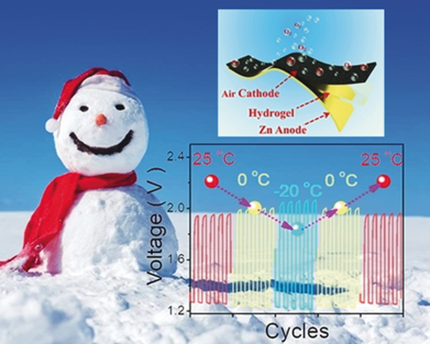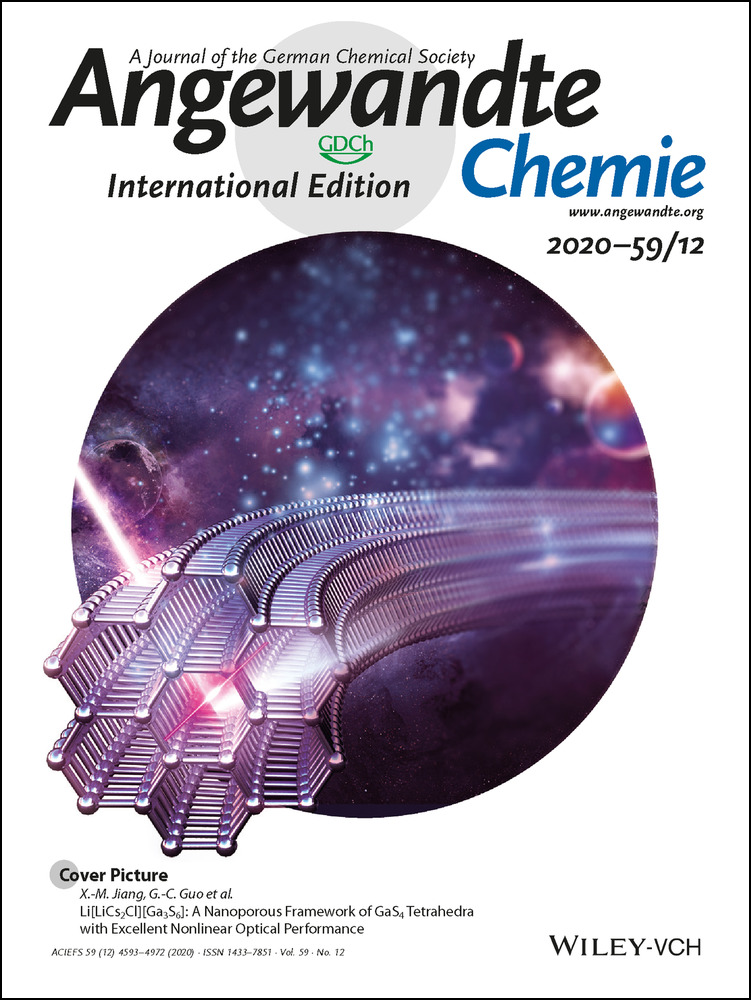A Flexible Rechargeable Zinc–Air Battery with Excellent Low-Temperature Adaptability
Dr. Zengxia Pei
School of Chemical and Biomolecular Engineering, The University of Sydney, Sydney, New South Wales, 2006 Australia
Search for more papers by this authorZiwen Yuan
School of Chemical and Biomolecular Engineering, The University of Sydney, Sydney, New South Wales, 2006 Australia
Search for more papers by this authorChaojun Wang
School of Chemical and Biomolecular Engineering, The University of Sydney, Sydney, New South Wales, 2006 Australia
Search for more papers by this authorDr. Shenlong Zhao
School of Chemical and Biomolecular Engineering, The University of Sydney, Sydney, New South Wales, 2006 Australia
Search for more papers by this authorJingyuan Fei
School of Chemical and Biomolecular Engineering, The University of Sydney, Sydney, New South Wales, 2006 Australia
Search for more papers by this authorDr. Li Wei
School of Chemical and Biomolecular Engineering, The University of Sydney, Sydney, New South Wales, 2006 Australia
Search for more papers by this authorJunsheng Chen
School of Chemical and Biomolecular Engineering, The University of Sydney, Sydney, New South Wales, 2006 Australia
Search for more papers by this authorCheng Wang
School of Chemical and Biomolecular Engineering, The University of Sydney, Sydney, New South Wales, 2006 Australia
Search for more papers by this authorRongjie Qi
School of Chemical and Biomolecular Engineering, The University of Sydney, Sydney, New South Wales, 2006 Australia
School of Mechanical Engineering, Shanghai Jiaotong Univerity, Shanghai, 200240 China
Search for more papers by this authorProf. Zongwen Liu
School of Chemical and Biomolecular Engineering, The University of Sydney, Sydney, New South Wales, 2006 Australia
Search for more papers by this authorCorresponding Author
Prof. Yuan Chen
School of Chemical and Biomolecular Engineering, The University of Sydney, Sydney, New South Wales, 2006 Australia
Search for more papers by this authorDr. Zengxia Pei
School of Chemical and Biomolecular Engineering, The University of Sydney, Sydney, New South Wales, 2006 Australia
Search for more papers by this authorZiwen Yuan
School of Chemical and Biomolecular Engineering, The University of Sydney, Sydney, New South Wales, 2006 Australia
Search for more papers by this authorChaojun Wang
School of Chemical and Biomolecular Engineering, The University of Sydney, Sydney, New South Wales, 2006 Australia
Search for more papers by this authorDr. Shenlong Zhao
School of Chemical and Biomolecular Engineering, The University of Sydney, Sydney, New South Wales, 2006 Australia
Search for more papers by this authorJingyuan Fei
School of Chemical and Biomolecular Engineering, The University of Sydney, Sydney, New South Wales, 2006 Australia
Search for more papers by this authorDr. Li Wei
School of Chemical and Biomolecular Engineering, The University of Sydney, Sydney, New South Wales, 2006 Australia
Search for more papers by this authorJunsheng Chen
School of Chemical and Biomolecular Engineering, The University of Sydney, Sydney, New South Wales, 2006 Australia
Search for more papers by this authorCheng Wang
School of Chemical and Biomolecular Engineering, The University of Sydney, Sydney, New South Wales, 2006 Australia
Search for more papers by this authorRongjie Qi
School of Chemical and Biomolecular Engineering, The University of Sydney, Sydney, New South Wales, 2006 Australia
School of Mechanical Engineering, Shanghai Jiaotong Univerity, Shanghai, 200240 China
Search for more papers by this authorProf. Zongwen Liu
School of Chemical and Biomolecular Engineering, The University of Sydney, Sydney, New South Wales, 2006 Australia
Search for more papers by this authorCorresponding Author
Prof. Yuan Chen
School of Chemical and Biomolecular Engineering, The University of Sydney, Sydney, New South Wales, 2006 Australia
Search for more papers by this authorGraphical Abstract
Powering the frozen world: The first flexible zinc–air battery with excellent low-temperature adaptability was achieved through the development of an innovative air-cathodic electrocatalyst and hydrogel electrolyte. The battery delivers a capacity of 691 mAh g−1 and an energy density of 798 Wh kg−1 at −20 °C, along with excellent flexibility and state-of-the-art low-temperature performance.
Abstract
Flexible zinc–air batteries (ZAB) are a promising battery candidate for emerging flexible electronic devices, but the catalysis-based working principle and unique semi-opened structure pose a severe challenge to their overall performance at cold temperature. Herein, we report the first flexible rechargeable ZAB with excellent low-temperature adaptability, based on the innovation of an efficient electrocatalyst to offset the electrochemical performance shrinkage caused by decreased temperature and a highly conductive hydrogel with a polarized terminal group to render the anti-freezing property. The fabricated ZABs show excellent electrochemical performances that outperform those of many aqueous ZABs at room temperature. They also deliver a high capacity of 691 mAh g−1 and an energy density of 798 Wh kg−1 at −20 °C (92.7 % and 87.2 % retention of the room temperature counterparts, respectively), together with excellent flexibility and reverting capability.
Conflict of interest
The authors declare no conflict of interest.
Supporting Information
As a service to our authors and readers, this journal provides supporting information supplied by the authors. Such materials are peer reviewed and may be re-organized for online delivery, but are not copy-edited or typeset. Technical support issues arising from supporting information (other than missing files) should be addressed to the authors.
| Filename | Description |
|---|---|
| anie201915836-sup-0001-misc_information.pdf2 MB | Supplementary |
Please note: The publisher is not responsible for the content or functionality of any supporting information supplied by the authors. Any queries (other than missing content) should be directed to the corresponding author for the article.
References
- 1
- 1aA. Nathan, A. Ahnood, M. T. Cole, S. Lee, Y. Suzuki, P. Hiralal, F. Bonaccorso, T. Hasan, L. Garcia-Gancedo, A. Dyadyusha, Proc. IEEE 2012, 100, 1486–1517;
- 1bW. Liu, M. S. Song, B. Kong, Y. Cui, Adv. Mater. 2017, 29, 1603436;
- 1cS. Zhai, H. E. Karahan, C. Wang, Z. Pei, L. Wei, Y. Chen, Adv. Mater. 2020, 32, 1902387.
- 2
- 2aJ. S. Lee, S. T. Kim, R. Cao, N. S. Choi, M. Liu, K. T. Lee, J. Cho, Adv. Energy Mater. 2011, 1, 34–50;
- 2bY. Li, H. Dai, Chem. Soc. Rev. 2014, 43, 5257–5275;
- 2cJ. Fu, Z. P. Cano, M. G. Park, A. Yu, M. Fowler, Z. Chen, Adv. Mater. 2017, 29, 1604685;
- 2dP. Tan, B. Chen, H. Xu, H. Zhang, W. Cai, M. Ni, M. Liu, Z. Shao, Energy Environ. Sci. 2017, 10, 2056–2080.
- 3L. An, B. Huang, Y. Zhang, R. Wang, N. Zhang, T. Dai, P. Xi, C.-H. Yan, Angew. Chem. Int. Ed. 2019, 58, 9459–9463; Angew. Chem. 2019, 131, 9559–9563.
- 4
- 4aX. Wang, H. Zhang, H. Lin, S. Gupta, C. Wang, Z. Tao, H. Fu, T. Wang, J. Zheng, G. Wu, X. Li, Nano Energy 2016, 25, 110–119;
- 4bW. Jiang, L. Gu, L. Li, Y. Zhang, X. Zhang, L. Zhang, J. Wang, J. Hu, Z. Wei, L. Wan, J. Am. Chem. Soc. 2016, 138, 3570–3578;
- 4cC. Y. Su, H. Cheng, W. Li, Z. Q. Liu, N. Li, Z. Hou, F. Q. Bai, H. X. Zhang, T. Y. Ma, Adv. Energy Mater. 2017, 7, 1602420;
- 4dZ. Pei, H. Li, Y. Huang, Q. Xue, Y. Huang, M. Zhu, Z. Wang, C. Zhi, Energy Environ. Sci. 2017, 10, 742–749;
- 4eJ. Chen, L. Wei, A. Mahmood, Z. Pei, Z. Zhou, X. Chen, Y. Chen, Energy Storage Mater. 2019, https://doi.org/10.1016/j.ensm.2019.09.024;
- 4fA. Aijaz, J. Masa, C. Rösler, W. Xia, P. Weide, A. J. Botz, R. A. Fischer, W. Schuhmann, M. Muhler, Angew. Chem. Int. Ed. 2016, 55, 4087–4091; Angew. Chem. 2016, 128, 4155–4160;
- 4gZ. Pei, Y. Huang, Z. Tang, L. Ma, Z. Liu, Q. Xue, Z. Wang, H. Li, Y. Chen, C. Zhi, Energy Storage Mater. 2019, 20, 234–242;
- 4hX. Liu, M. Park, M. G. Kim, S. Gupta, G. Wu, J. Cho, Angew. Chem. Int. Ed. 2015, 54, 9654–9658; Angew. Chem. 2015, 127, 9790–9794.
- 5
- 5aX. Wang, Y. Li, T. Jin, J. Meng, L. Jiao, M. Zhu, J. Chen, Nano Lett. 2017, 17, 7989–7994;
- 5bH. Zhu, L. Gu, D. Yu, Y. Sun, M. Wan, M. Zhang, L. Wang, L. Wang, W. Wu, J. Yao, Energy Environ. Sci. 2017, 10, 321–330;
- 5cY. Fu, H. Y. Yu, C. Jiang, T. H. Zhang, R. Zhan, X. Li, J. F. Li, J. H. Tian, R. Yang, Adv. Funct. Mater. 2018, 28, 1705094;
- 5dH. Tang, W. Chen, J. Wang, T. Dugger, L. Cruz, D. Kisailus, Small 2018, 14, 1703459.
- 6
- 6aA. Sumboja, X. Ge, Y. Zong, Z. Liu, Funct. Mater. Lett. 2016, 9, 1630001;
- 6bZ. Wang, H. Li, Z. Tang, Z. Liu, Z. Ruan, L. Ma, Q. Yang, D. Wang, C. Zhi, Adv. Funct. Mater. 2018, 28, 1804560.
- 7N. Choudhury, S. Sampath, A. Shukla, Energy Environ. Sci. 2009, 2, 55–67.
- 8
- 8aQ. Rong, W. Lei, L. Chen, Y. Yin, J. Zhou, M. Liu, Angew. Chem. Int. Ed. 2017, 56, 14159–14163; Angew. Chem. 2017, 129, 14347–14351;
- 8bF. Chen, D. Zhou, J. Wang, T. Li, X. Zhou, T. Gan, S. Handschuh-Wang, X. Zhou, Angew. Chem. Int. Ed. 2018, 57, 6568–6571; Angew. Chem. 2018, 130, 6678–6681;
- 8cL. Han, K. Liu, M. Wang, K. Wang, L. Fang, H. Chen, J. Zhou, X. Lu, Adv. Funct. Mater. 2018, 28, 1704195.
- 9F. Mo, G. Liang, Q. Meng, Z. Liu, H. Li, J. Fan, C. Zhi, Energy Environ. Sci. 2019, 12, 706–715.
- 10Y. Huang, Z. Li, Z. Pei, Z. Liu, H. Li, M. Zhu, J. Fan, Q. Dai, M. Zhang, L. Dai, Adv. Energy Mater. 2018, 8, 1802288.
- 11J. Wei, G. Wei, Y. Shang, J. Zhou, C. Wu, Q. Wang, Adv. Mater. 2020, 32, 1900248.
- 12H. Dong, N. Wang, L. Wang, H. Bai, J. Wu, Y. Zheng, Y. Zhao, L. Jiang, ChemPhysChem 2012, 13, 1153–1156.
- 13
- 13aS. V. Fridrikh, H. Y. Jian, M. P. Brenner, G. C. Rutledge, Phys. Rev. Lett. 2003, 90, 144502;
- 13bC. Niu, J. Meng, X. Wang, C. Han, M. Yan, K. Zhao, X. Xu, W. Ren, Y. Zhao, L. Xu, Nat. Commun. 2015, 6, 7402.
- 14T. Zhou, W. Xu, N. Zhang, Z. Du, C. Zhong, W. Yan, H. Ju, W. Chu, H. Jiang, C. Wu, Adv. Mater. 2019, 31, 1807468.
- 15Q. Lin, X. Bu, A. Kong, C. Mao, F. Bu, P. Feng, Adv. Mater. 2015, 27, 3431–3436.
- 16M. Liu, T. Guo, J. Appl. Polym. Sci. 2001, 82, 1515–1520.
- 17L. B. Lane, Ind. Eng. Chem. 1925, 17, 924–924.





